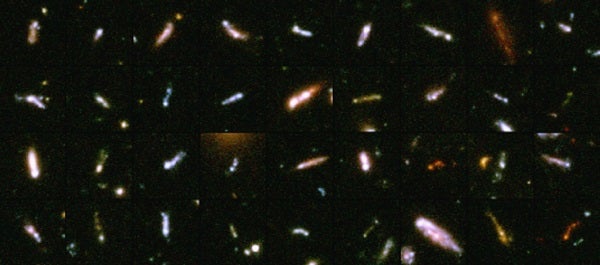Q: Were the universe’s early galaxies much different from the galaxies of today?
A: Yes! General comparisons of galaxies in the early universe (or similarly, the “high-redshift” universe) against those in the local universe (within about 20 million light-years of Earth) reveal that these two groups can be remarkably different.
The reason why galaxies appear so different between our local universe and the distant one is because we are observing galaxies at different stages of their evolution as we look out in space. Telescopes are time machines, albeit ones that run only in reverse, and so the farther out we look with them, the progressively younger universe we see. Furthermore, we do not observe the universe from any special vantage point. So if we make the reasonable assumption that the physical laws we measure in the local cosmos are universal, we can conclude that the galaxies we observe in the early universe are analogous to the predecessors of the local galaxies. Thus, the differences we see between the different populations of galaxies provide direct insights into the nature of galaxy evolution.
One way to distinguish galaxies is by their star formation rates, or the “vigorousness” with which they form new stars. When we look close to home — in our Milky Way, the neighboring Andromeda Galaxy (M31), and even the local “starburst” galaxies like the Cigar Galaxy (M82) — we observe these galaxies forming stars at a meager rate of about 1 to 10 solar masses per year, on average.
Galaxies in the early universe were far more active on average than our Milky Way. Astronomers have used space-based observatories, such as the Hubble, Spitzer, and Herschel telescopes, to conduct large surveys of distant galaxies, and they commonly observe star formation rates of hundreds of solar masses per year.
As stars live, the nuclear fusion at their cores produces elements heavier than helium, which astronomers call metals, much to the dismay of our chemistry colleagues. When these suns die and spew those metals into space, winds and stellar explosions transport that material and “pollute” the galaxy. We would therefore expect that younger galaxies would have fewer metals in comparison to galaxies that have experienced multiple successive periods of star formation. Many studies have conformed this. For example, using Hubble’s near-infrared capabilities, astronomers have found the average abundances of metals have nearly tripled over the past 10 billion years.
The shapes of galaxies in the early universe differ from those today in many ways as well. We group most massive galaxies (roughly the size of the Milky Way or larger) in the nearby universe into two general classes: “late-type” spirals (like our galaxy and M31) and “early-type” ellipticals (like M87). We also have a class for irregular galaxies (like the Magellanic Clouds).
But even a glance at the Hubble Ultra Deep Field image — a 270-hour exposure of the high-redshift universe — suggests a startling diversity in the shapes of galaxies in the early universe. Instead of spirals and ellipticals, most of these galaxy shapes need an entirely different vocabulary of “tadpoles,” “clumps,” and “chains” to describe them. And when we find high-redshift galaxies with shapes reminiscent of local spirals and ellipticals, these objects differ from galaxies near us. For example, elliptical galaxies at a redshift of 2 (when the universe was about 3.5 billion years old) of the same mass as those today are more compact — they have more mass within a smaller radius — by roughly a factor of three compared to their local counterparts.
University of Minnesota, Minneapolis










